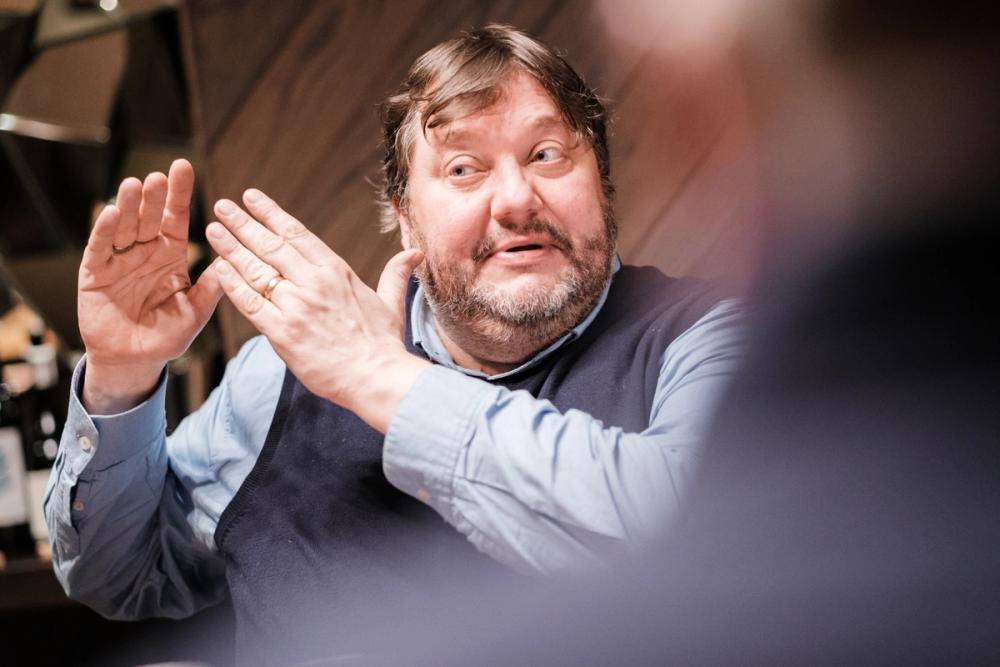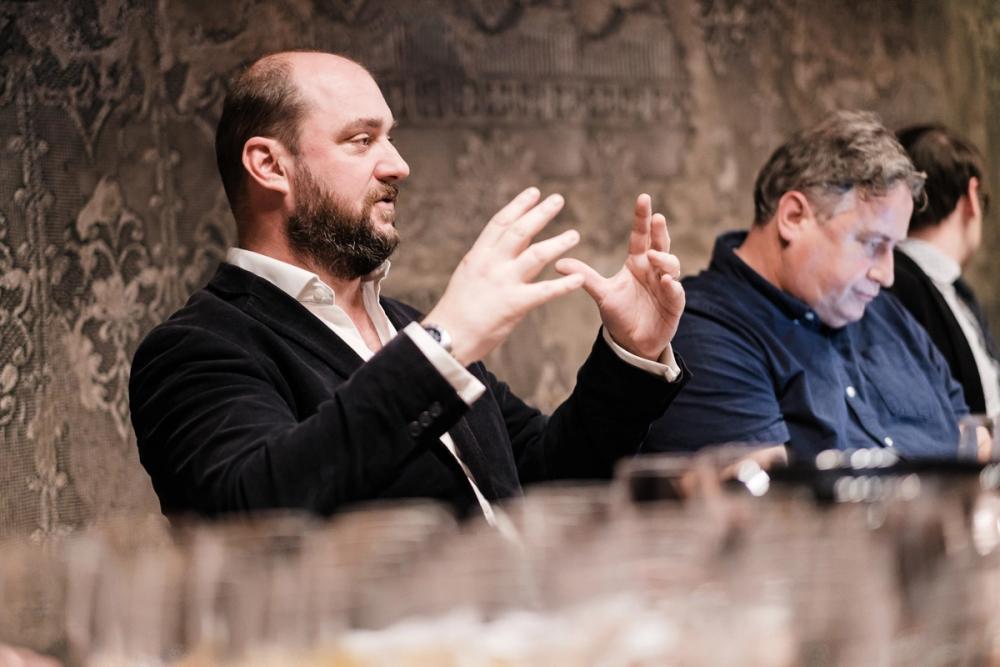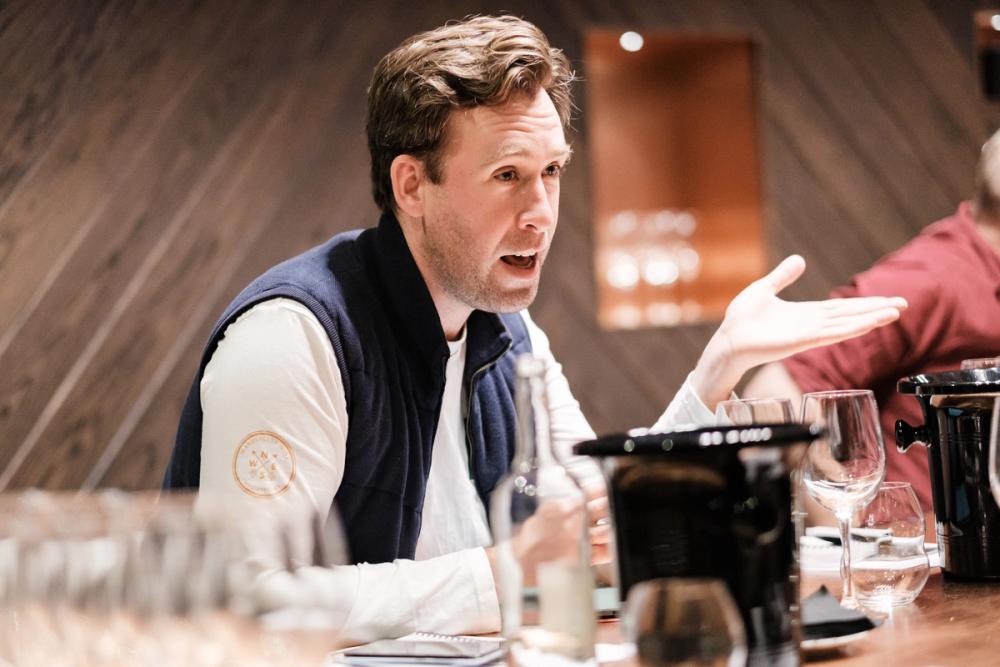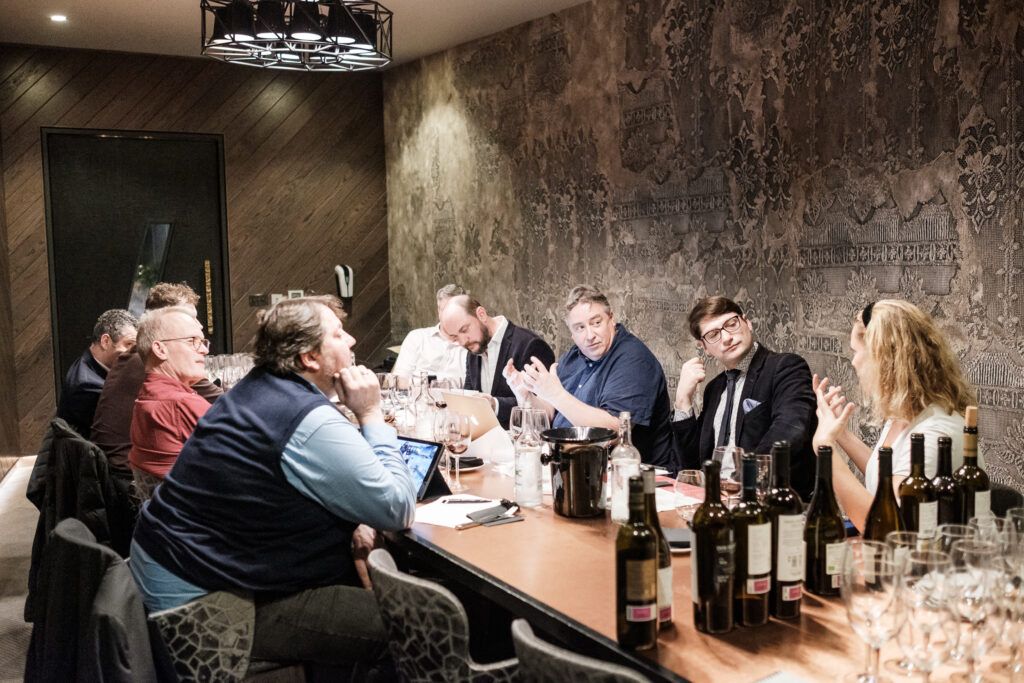The Buyer would like to thank Tim Atkin MW and our Ribera del Duero panel for taking part and sharing their views. The panel was made up of Maggie Macpherson, group wine buyer at Jeroboams; Richard Ellison, founder and managing director at Wanderlust Wine; André Luis Martins, head sommelier at The Cavalry and Guards Club; wine broadcaster, Joe Wadsack; Paul Belcher, chef and owner of the Tapas Room group of restaurants in south London; consultant and buyer, Harry Crowther, wine buyer for Good Pair Days, the new e-commerce site and wine club; and wine buyer and columnist, Douglas Blyde. The second part of the debate report will be published later in the week.

A panel of leading buyers, merchants, sommeliers and consultants came together to discuss the potential for Ribera del Duero in the UK. Photography Thomas Skovsende.
It’s probably a fair bet to say that whilst the vast majority of wine professionals would pick out Ribera del Duero as being one of Spain’s most important wine regions, not many could then go on and give a 10 minute talk on the region, in the same way they could for other classic European wine regions, without doing their research.
For whilst Ribera del Duero has a reputation for producing quality, and in some cases iconic, red wines – step forward Vega Sicilia – it is not widely seen to offer as much choice and diversity as buyers might find in other wine regions. However, this couldn’t be further from the truth; the different altitudes and soils, positions both North and South of the Duero, age of the vines and talent of winemakers who are able to create their own, evolving style all mean that Ribera del Duero offers an incredible variety of wines.
That’s what this debate and session was all about. To lift up the bonnet, as it were, on Ribera del Duero, and let buyers and top wine consultants examine, discuss and also discover what the region has to offer that they may not have been fully aware of.
To help guide us was arguably Ribera del Duero’s biggest UK champion – Tim Atkin MW – who, for the last five years, has travelled extensively throughout the region, tasting 1,000s of wines, 10% if which have gone on to feature one his annual Ribera del Duero Top 100 list, and for the first time in 2021, a Special Report on the region,
‘One of world’s great wine regions’
Atkin is in no doubt that Ribera del Duero has developed in recent years and has become “one of the great wine regions of the world,” adding that “if you take the trouble to look, there is much to explore, excite and intrigue even the most jaded wine buyer.” Its key point of difference, he argues, is that it is a region that is continually evolving and developing, and that in many ways, its best years are still ahead of it.

Tim Atkin MW believes Ribera del Duero is now “one of the great wine regions of the world”. Photograph Thomas Skovsende
Bear in mind that even though the Romans were making wine here some 2,000 years ago, this is a DO that was only officially formed in 1982, so is still incredibly young as a fine wine region.
Like so much of the world, its producers are only now really starting to understand just what different soil types, altitudes and climate conditions mean in terms of making wines that have a true sense of place and are able to influence each other one year after the next.
For a start, there are many more producers making wine in the region: there are over 300 wineries now versus around 75 in the early 1990s, with 25,000 hectares of vines compared to 9,000 in 1991 and 6,000 in the early 1970s. All are now producing a wide tapestry of elegant and refined red, white and rosé wines made up of Cosechas and Crianzas, Reservas and Gran Reservas.
Atkin says the huge changes taking place in the region are reflected in the increase in producers scoring higher points in his 2021 Top 100. Crucially, he adds, the emphasis is now very much on producing “elegant wines” that have “freshness and balance” and are a clear move away from the more traditional “powerful” higher in alcohol wines of the past, where there was much “reliance on colour and oak, rather than fruit and acidity.”
Better understanding
These changes are not just driven by what is happening in the winery, but a better understanding of the topography of the region and what more needs to be done in the vineyards with the grapes, vines and leaves throughout the growing period.

Joe Wadsack says he is impressed by how many producers have changed the way they make their wines to be more consumer friendly. Picture Thomas Skovsende
Ribera del Duero enjoys a largely continental climate with huge temperature differences between the intensely hot summers and sometimes long, bitterly cold winters. The differences between day and night temperatures in the summer can be as much as 28 degrees Celsius with average yearly rainfall only 435mm. The climate in Ribera del Duero is often described as “nine months of winter and three months of hell.”
In addition, there are a lot of differences between vines grown higher and lower up and down the region, and, in particular their proximity to the all-important Duero river that runs through it, dropping a kilometre as it goes.
There is also a large proportion of old bush vines in the region – with 817 hectares of vines planted before 1920.
Atkin says that even in the west of the region, where the lowest altitude vines are grown, vines are still being planted at 800m above sea level which is high for Europe. In fact, many vines in Ribera del Duero are located at 900m to 1000m. The key difference happening in the region now is that producers are starting to really understand the prime locations for planting vines and which of its 30 plus different soil types are the ones to be focused on for making quality, premium wine. “There are huge differences from one village to another,” he says.
Only by visiting the area do you truly appreciate just how diverse it is. In fact, Atkin even likens Ribera del Duero to Burgundy. Not only are they both long and thin (Ribera del Duero is 115 km long and 35 km wide), but the land varies enormously in terms of the type and styles and quality of wine that can be made within a few hundred metres.
Panel’s perceptions

Paul Belcher says he loves promoting Ribera del Duero wines to his customers at The Tapas Room. Picture by Thomas Skovsende.
Paul Belcher, chef and owner of the Tapas Room group of restaurants in South London, sees Ribera del Duero as the “second wine of Spain” and usually has a nice selection on his dedicated Spanish wine list. It is also, he adds, a way to introduce different wine styles from Spain to his customers, and avoid them just going for a Rioja as an easy choice.
“We really enjoy selling our Ribera del Duero wines and seeing the response from customers. People are definitely starting to become much more aware of the region,” he says.
Richard Ellison at Wanderlust Wine, the wine importer that goes direct to consumers as well as having a successful on and off-trade wholesale business, says it is noticeable how many of the big wine producers from other Spanish wine regions, particularly Rioja, have moved in to Ribera del Duero and are now developing and investing in major projects there. “They clearly see the potential that Ribera del Duero has in the future,” he adds.
It’s a region that Wanderlust has yet to import any wine from, but Ellison was keen to take part in the panel as it is very much on his radar. “We started with Rioja as it made sense to go with a region that has its own reputation and that people have a general understanding and perception of. Ribera del Duero is a harder call to make in terms of what style you are going to get from the region and what price point you can confidently command. But we are very interested. It’s also good to see Clarete [a unique blend of red and white grapes], which it used to be so famous for, making a comeback as well.”

Richard Ellison says he is keen to see more wines and understand the Ribera del Duero better
Rioja is after all around three times its size and offers a much wider selection of lower-priced wines, with grapes priced at between €1 to €2 a litre compared to €0.50 and €0.80 in Rioja thanks to its higher yields, says Atkin. “Ribera de Duero has always maintained its premium image,” he adds.
Harry Crowther, the wine buyer for Good Pair Days, agrees there is a natural tendency for buyers to lean more towards Rioja than Ribera del Duero. But there is no real reason for doing so. He says the key for him when sourcing wines from Ribera del Duero is to look for a balance between what he sees as its two main styles: restraint and its polished more luxury wines. Finding wines that can get the right mix of the two is his sweet spot.
Joe Wadsack says he used to buy a lot of Ribera del Duero wines during his wine buying days at Waitrose when it was regarded a bit of a “one trick pony”, ideal for people trading up at Christmas. “It was a wine you bought as a present,” he says.
He was interested to see how many of the producers he remembers from those days are now branching out and making wines that are much more consumer-focused and accessible, and suggested that this should get more people trying the region’s wines.
He says its challenge is now a “communications job.”
Wanting to list more…

Maggie Macpherson says Ribera del Duero needs to work on its wider image to appeal to a wider consumer base. Picture Thomas Skovsende
Maggie Macpherson says Jeroboams currently has one Ribera del Duero wine as part of its range but is very open to taking on more producers. “It has a got strong following and it does well, but I think overall people struggle to understand the region as much as they do Rioja as they don’t really know it,” she adds. “However, it offers incredible value against some of its counterparts in Rioja and fits in nicely with people wanting to discover new things and new styles of wine. The fact there are a lot of younger winemakers there looking to do different things also really appeals to me.”
Atkin says it is not surprising Ribera del Duero’s profile is not as big as other Spanish wine regions when you consider two of its biggest and most prestigious names – Vega Sicilia and Dominio de Pingus – are not necessarily well-known for coming from the region.
The Pingus PSI is certainly what keeps André Luis Martins coming back to Ribera del Duero. “I just love the PSI. I buy it every year. Peter Sisseck has got such a good project there. I always have a good selection of Ribera del Duero on my list. It is a great option to have to talk to guests about. It is also less expensive than a lot of Bordeaux styles. I really like what I am seeing coming from the region.”
Douglas Blyde says he has seen a lot more interest in Ribera del Duero from serious private investors, which is, in part, driven by the reputation and prestige of wines such as the Pingus PSI. “Investors now understand what they are getting and buying into,” he says.
Luis Martins says he would like to see more of his suppliers take Ribera del Duero more seriously so that he has more wines being offered to him from the region. “I think some distributors are missing out by not focusing on Ribera del Duero. I would love to see them change their views. They need to focus on different areas and not all follow the same classic areas.”

Andrew Luis Martins really supports and promotes Ribera del Duero wines with his customers. Picture Thomas Skovsende.
He says he has taken a personal interest in pushing and promoting wines from Ribera del Duero and is pleased that some of his customers will come in and ask him to personally recommend a wine for them from the region.
The region’s perceived ‘under the radar’ status is certainly what attracted Atkin to go and explore and delve into what it can offer. He says there is so much for the trade to discover and he is particularly pleased to hear how its blends are starting to gain real interest amongst serious buyers and how it is fast becoming an alternative to high end Bordeaux, with so much more potential from all the “activity” coming from younger winemakers.
He also believes the region is following the right pricing strategy “from the top down” and that it has avoided Rioja’s mistake of trying to build a quality image from the “bottom up”. “Ribera del Duero already has its crown jewels,” says Atkin, and he hopes his Top 100 Selection can show how much more the region has to offer.
The advantage that Ribera del Duero has is that people don’t have a set image of what it is yet, he adds. “There are certainly more exciting producers in Ribera del Duero than there are in Rioja. I am happy to repeat myself and say it is one of the most exciting regions in Europe.”
- You can find out more about the region at its main generic website here.
- Part Two of our report will be published later in the week when the panel give their views on a selection of wines tasted to see how they best reflect on what Ribera del Duero can offer.
- Our thanks to team at M Victoria for hosting the event in its private dining room.









































